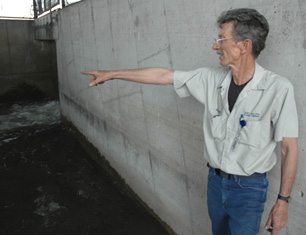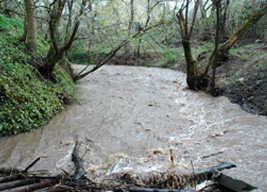2006 Spring Run-off Watch
Above normal snowpack alerts Stormwater crews
April 20, 2006
|
This wetter weather pattern has continued into 2006 producing Snow Water Equivalent (SWE) values well above normal. The Wasatch Front, in particular, received copious amounts of snow at both the mid and high elevations. At the March 24 Public Utilities Advisory Committee meeting, National Resource Conservation Service snow survey manager Randy Julander said that the Provo River – Utah Lake – Jordan River drainage was 125 percent of normal. He noted that the snowpack at Lookout Peak, which is just over the ridge of the headwaters of City Creek, is now in record territory at 175 percent of normal. The snowpack in City Creek contained 30.2 inches of SWE at the Louis Meadows snow course.
Last year the snowpack at this SNOWTEL station was about 20 inches. Julander said that based on the snowpack in City Creek, we should anticipate high flows during this spring run-off. Flooding would depend on the run-off hydrograph. If the spring is cooler and wetter, compressing the run-off period, this will enhance the chances of extremely high creek flows. “The climatological conditions in the spring have a lot to do with how high the peak flow is going to be – that’s the stuff we just can’t forecast,” said Julander.
In the published April 2006 Colorado Basin River Forecast Center forecast, the 6-canyon run-off flows, based on a 50 percent probability, showed higher than normal peak flows during the run-off period. The April 1 forecast projected a peak flow of 220 cfs with the City Creek to Jordan River stormdrain system modeled to carry 210 cfs. This forecast has raise concern over the possibility of flooding on City Creek.
On April 12, Public Utilities, City Emergency Services, City Parks, County Flood Control and Weather Service representatives met to discuss the potential for flooding.
The projected City Creek run-off of 220 cfs is a far cry from the record 322 cfs that caused the 1983 flood and resulting State Street River. However, there is always the potential for unusually hot weather or a heavy rain event on top of the snowmelt that would cause flooding.
Elsewhere in the Wasatch Canyon watershed, in anticipation for high run-off in the Parley’s watershed, water releases from Mt.Dell began on February 15 to make room for projected high peak flows
All of the canyon flows through the city are projected to be above normal. Likewise, the Jordan River and Surplus Canal are both expected to run full. With the 125 percent above average snowpack in the Provo River-Utah Lake- Jordan River drainage, the waters flowing into Utah Lake will be passed through to the Jordan River/Surplus Canal without the benefit of storage. The lake reached compromise in late February and the gates were opened pursuant to the 1986 Utah Lake agreement. Jordanelle and Deer Creek reservoirs are nearly full and will not be able to store much of the run-off flowing into the Provo River drainage.
|
In preparing for the upcoming spring run-off, Public Utilities employees are gearing up to do their part in operating flood control facilities and managing the high flows. “This spring run-off period is going to keep us on our toes,” said stormwater foreman E.V. Holland. The stormwater crews have inspected the stream beds and stormdrains to make sure they are clear of obstructions. Watershed and maintenance crews are clearing deadfall trees from the streambed in City Creek.

